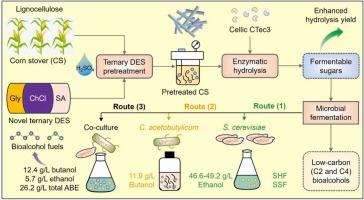当前位置:
X-MOL 学术
›
Ind. Crops Prod.
›
论文详情
Our official English website, www.x-mol.net, welcomes your
feedback! (Note: you will need to create a separate account there.)
Conversion of biomass to biofuels: Integration of a ternary deep eutectic solvent pretreatment and microbial fermentation for C2-C4 bioalcohols production from lignocellulose
Industrial Crops and Products ( IF 5.6 ) Pub Date : 2024-07-23 , DOI: 10.1016/j.indcrop.2024.119271 Hongzhen Luo , Tairan Zhou , Rui Zhang , Qianyue Yang , Xinyan You , Shijie Wang , Jiabin Wang , Fang Xie , Rongling Yang
Industrial Crops and Products ( IF 5.6 ) Pub Date : 2024-07-23 , DOI: 10.1016/j.indcrop.2024.119271 Hongzhen Luo , Tairan Zhou , Rui Zhang , Qianyue Yang , Xinyan You , Shijie Wang , Jiabin Wang , Fang Xie , Rongling Yang

|
Efficient production of second-generation biofuels (bioethanol and biobutanol) from renewable lignocellulosic biomass holds strategic importance and aligns with sustainability objectives. However, it poses a persistent long-term challenge because of the biomass recalcitrance. Therefore, development of mild, environmentally friendly biomass pretreatment methods is a critical concern. To this end, in this study, a ternary deep eutectic solvent (DES) was synthesized with choline chloride, succinic acid, and glycerol at a molar ratio of 1:0.5:0.5. The ternary DES pretreatment largely enhanced glucan digestibility of corn stover (CS) to 94.7 % which was 4.60-fold to untreated CS. Mechanism of improved enzymatic efficiency of DES-pretreated CS was revealed by characterization methods such as SEM, XRD, and FTIR technologies. In addition, adding 1.0 % HSO to the ternary DES further increased enzymatic hydrolysis yield to nearly 100 %. Subsequently, the HSO-assisted DES-pretreated CS was used as substrate to produce C2-C4 bioalcohols (ethanol and butanol) by microbial fermentations. The results indicate that 46.6–49.2 g/L ethanol could be obtained by under separate hydrolysis and fermentation (SHF), and simultaneous saccharification and fermentation (SSF) strategies. Meanwhile, up to 11.9 g/L butanol was achieved from CS hydrolysate by with fed-batch mode. Finally, an artificial microbial consortium by co-culturing and was developed which efficiently co-produced 12.4 g/L biobutanol and 5.7 g/L bioethanol from CS hydrolysate. Overall, this study provides a sustainable and green pretreatment technology that deconstruct lignocellulose and possess universality to produce various low-carbon bioalcohols by microbial fermentations.
中文翻译:

生物质转化为生物燃料:三元低共熔溶剂预处理和微生物发酵相结合,从木质纤维素生产 C2-C4 生物醇
利用可再生木质纤维素生物质高效生产第二代生物燃料(生物乙醇和生物丁醇)具有战略重要性,并且符合可持续发展目标。然而,由于生物量的顽抗,它带来了持续的长期挑战。因此,开发温和、环保的生物质预处理方法至关重要。为此,本研究以氯化胆碱、琥珀酸和甘油以1:0.5:0.5的摩尔比合成了三元低共熔溶剂(DES)。三元DES预处理将玉米秸秆(CS)的葡聚糖消化率大大提高至94.7%,是未处理CS的4.60倍。通过 SEM、XRD 和 FTIR 技术等表征方法揭示了 DES 预处理 CS 提高酶效率的机制。此外,在三元 DES 中添加 1.0% HSO 进一步将酶水解产率提高至接近 100%。随后,以HSO辅助的DES预处理的CS为底物,通过微生物发酵生产C2-C4生物醇(乙醇和丁醇)。结果表明,通过单独水解发酵(SHF)和同时糖化发酵(SSF)策略可以获得46.6-49.2 g/L的乙醇。同时,通过分批补料模式从 CS 水解产物中获得了高达 11.9 g/L 的丁醇。最后,通过共培养开发了一种人工微生物群落,可以从 CS 水解产物中有效地联产 12.4 g/L 生物丁醇和 5.7 g/L 生物乙醇。总体而言,本研究提供了一种可持续、绿色的预处理技术,可以解构木质纤维素,并具有通过微生物发酵生产各种低碳生物醇的通用性。
更新日期:2024-07-23
中文翻译:

生物质转化为生物燃料:三元低共熔溶剂预处理和微生物发酵相结合,从木质纤维素生产 C2-C4 生物醇
利用可再生木质纤维素生物质高效生产第二代生物燃料(生物乙醇和生物丁醇)具有战略重要性,并且符合可持续发展目标。然而,由于生物量的顽抗,它带来了持续的长期挑战。因此,开发温和、环保的生物质预处理方法至关重要。为此,本研究以氯化胆碱、琥珀酸和甘油以1:0.5:0.5的摩尔比合成了三元低共熔溶剂(DES)。三元DES预处理将玉米秸秆(CS)的葡聚糖消化率大大提高至94.7%,是未处理CS的4.60倍。通过 SEM、XRD 和 FTIR 技术等表征方法揭示了 DES 预处理 CS 提高酶效率的机制。此外,在三元 DES 中添加 1.0% HSO 进一步将酶水解产率提高至接近 100%。随后,以HSO辅助的DES预处理的CS为底物,通过微生物发酵生产C2-C4生物醇(乙醇和丁醇)。结果表明,通过单独水解发酵(SHF)和同时糖化发酵(SSF)策略可以获得46.6-49.2 g/L的乙醇。同时,通过分批补料模式从 CS 水解产物中获得了高达 11.9 g/L 的丁醇。最后,通过共培养开发了一种人工微生物群落,可以从 CS 水解产物中有效地联产 12.4 g/L 生物丁醇和 5.7 g/L 生物乙醇。总体而言,本研究提供了一种可持续、绿色的预处理技术,可以解构木质纤维素,并具有通过微生物发酵生产各种低碳生物醇的通用性。











































 京公网安备 11010802027423号
京公网安备 11010802027423号